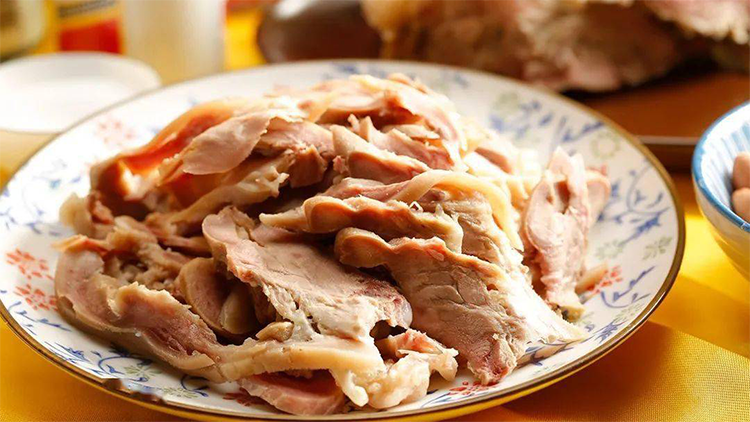Discover Ningxia’s White-Boiled Lamb Head: A Pure Taste of the Northwest
On the wide plains of Ningxia, nourished by the Yellow River, some of China’s finest lamb is raised. The region’s simplest yet most profound expression of that bounty is the white-boiled lamb head—a Halal specialty with roots dating back to the Ming and Qing dynasties. Known locally as Baishui Yangtou, this traditional Ningxia street food celebrates pure ingredients and understated technique, offering a clear, savory taste that reveals the land’s natural richness.
1. Origins and a Long Culinary Echo
The history of white-boiled lamb head dates to the Ming and Qing eras. Ningxia, historically a crossroads for trade and pastoral life, prized every part of the sheep. What might once have been considered humble offal was transformed by the ingenuity of local Han and Hui communities into a beloved delicacy. From home kitchens to market stalls, its exceptional flavor spread across the region and became an iconic traditional Ningxia snack.
2. Cultural Meaning: Simplicity as Philosophy
In Ningxia, white-boiled lamb head is more than a dish—it’s a cultural symbol. It reflects the northwest’s spirit of resourcefulness and a culinary philosophy that values natural, unadorned flavors. For warm-hearted locals, a plate of thinly sliced lamb head served with a pot of strong liquor is the perfect way to socialize and relax. Found both at bustling night markets and family dinner tables, this Halal lamb dish bridges communities and traditions, representing Ningxia’s multicultural food heritage.

3. The Ingredient Secret: Gifts from a Golden Pasture
The exquisite taste of this dish begins with Ningxia’s Tan sheep, known for grazing on medicinal grasses and drinking from mineral-rich springs. Their tender, finely textured meat has minimal gaminess and a subtle milky sweetness. The best versions use fresh local lamb heads, ideally from young lambs. This high-quality ingredient provides the pure foundation that defines the white-boiled cooking method.
4. Craftsmanship in Cooking: Simple but Demanding
“White-boiled” describes a method that seems simple—cooking in plain water without heavy seasonings—but it demands precision. The lamb head must be carefully cleaned: singed to remove fine hairs, scraped, and thoroughly washed. It’s simmered whole or halved in cold water, brought to a boil while skimming impurities, then gently simmered.
Aside from a little ginger and salt, no spices are added. Timing is key: cook long enough for the meat to become tender and easy to pull with chopsticks, but not so long that it falls apart. The slow simmer releases collagen and flavor, leaving a clear, savory broth and tender meat that shines in its simplicity.

5. Signature Flavors and Textures
A perfectly prepared white-boiled lamb head looks pale and clean, offering a range of textures. The cheek meat is tender and flavorful; the tongue is springy and smooth; the gelatinous areas around the eye are silky and rich. The overall taste is bright and meaty, without heavy gaminess—just a pure, lingering aroma of lamb that becomes sweeter with each bite. It embodies the idea of “great taste in restraint.”
6. Authentic Ways to Eat It
Traditionally, the cooled lamb head is thinly sliced by skilled vendors. Customers can choose fattier or leaner cuts—each offering a distinct mouthfeel. The slices are neatly arranged and paired with the dish’s essential condiment: pepper-salt.
This seasoning is made by toasting and grinding Sichuan peppercorns with coarse salt, and sometimes a hint of cumin. It brightens and enhances the lamb’s natural sweetness. Eat the slices plain first, then dip them into the pepper-salt to experience the contrast. The dish pairs beautifully with local eight-treasure tea, baked breads, or a cold beer—making it both a street snack and a social delight.

7. Tips for Visitors
- Best places to try: Visit Yinchuan’s Huaiyuan Night Market or Nanfeng Road Snack Street, where long-standing vendors serve authentic versions using traditional methods.
- How to order: You can buy by weight (for example, “half a jin”) or ask the vendor for a mix of different cuts.
- Pairings: Enjoy with hot eight-treasure tea to cut through richness, or a cold local beer.
- Eating advice: The dish is typically served cold and safe to eat. If sensitive to Sichuan pepper, ask for light or no pepper-salt.
8. An Easy Home Version
You can recreate this classic at home even without Ningxia’s local lamb.
Ingredients: One cleaned lamb head (prepared by the butcher), fresh ginger, coarse salt, Sichuan peppercorns.
Steps:
- Rinse the lamb head thoroughly.
- Place in cold water with ginger; bring to a boil and skim off foam.
- Lower the heat and simmer for 2–3 hours until tender.
- Remove and cool, then thinly slice or pull the meat apart.
- Toast Sichuan pepper and salt in a clean pan, grind into pepper-salt.
- Dip slices into the seasoning and enjoy.
The home version captures the same minimalist charm—showcasing tender meat, clean flavors, and natural aroma.

9. A Taste of Ningxia’s Soul
Ningxia white-boiled lamb head is a dish that reveals both culinary skill and cultural character. Its minimalist cooking technique preserves the meat’s natural flavor while expressing the honest simplicity of northwest China.
When traveling through Ningxia, don’t miss this centuries-old local specialty—a humble dish that tells a story of the land, its people, and their enduring love for pure, authentic taste.


